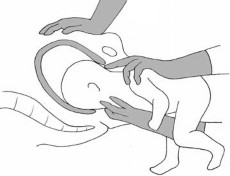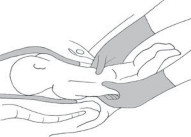Read Oxford Handbook of Midwifery Online
Authors: Janet Medforth,Sue Battersby,Maggie Evans,Beverley Marsh,Angela Walker
Oxford Handbook of Midwifery (88 page)
- The lie is longitudinal.
- The attitude is one of complete flexion.
- The presentation is breech.
BREECH DELIVERY
383
- The lie is longitudinal.
- The position is the right/left sacro-anterior/posterior.
- The denominator is the sacrum.
- The presenting part is the anterior buttock.
- The bitrochanteric diameter of 10cm enters the pelvis in the right or left oblique diameter of the brim.
Movements
- Descent occurs with compaction due to increased flexion of the limbs.

- The anterior buttock meets the resistance of the pelvic floor and undergoes internal rotation through 45° to the anterior. The
bitrochanteric diameter is then in the antero-posterior of the outlet.
- With lateral flexion of the trunk, the anterior buttock escapes under the pubic arch, the posterior buttock sweeps the pelvic floor and the body is born. The shoulders are entering the brim at this stage in the same oblique diameter as the bitrochanteric diameter. The diameter of the shoulders measures approximately 11cm.
- The buttocks undergo restitution and external rotation. This is accompanied by internal rotation of the shoulders, bringing the bisacromial diameter into the antero-posterior diameter of the outlet. The anterior shoulder escapes under the pubic arch, the posterior shoulder sweeps the pelvic floor, and the shoulders are delivered.
- The head enters the pelvis in the transverse diameter and internal rotation of the occiput through 90° to the anterior is accompanied by forward rotation of the back. The occiput escapes under the pubic arch and the mentum, face, sinciput, and vertex sweep the perineum and the head is born.
Obstetric management of the second stage
- It is crucial that full dilatation is confirmed by vaginal examination prior to allowing the woman to push. Await the descent of the presenting part. It should be visible at the perineum before active pushing begins.
- Inform the obstetrician, anaesthetist and paediatrician of the impending birth.
- In a multigravida or a small preterm fetus, the delivery may be spontaneous with minimal intervention.
- The lithotomy position may be adopted and sterile field prepared with drapes.
- Catheterization may be carried out to prevent delay and maximize the pelvic space.
- Preparation and equipment for a forceps delivery should be to hand but intervention should only be when strictly necessary. Allow spontaneous descent and birth.
- Infiltrate with local anaesthetic if needed when the buttocks distend the perineum.
- An episiotomy should only be performed if necessary to facilitate the birth.
- The buttocks should be born spontaneously.
- The baby then descends up to the umbilicus without intervention, if the legs are flexed they will deliver quite easily.
- If the cord is under tension, ease a loop down to avoid unnecessary traction.
CHAPTER 18
High-risk labour384
- With the next contraction, the shoulder blades appear, if the arms are flexed they will deliver easily.
- The shoulders rotate into the antero-posterior diameter of the outlet the body can be tilted towards the mother’s sacrum to facilitate delivery of the anterior shoulder. The posterior shoulder sweeps the perineum and is aided by lifting the buttocks towards the mother’s
 abdomen.
abdomen. - It is important that the baby is held only around the pelvic girdle and
handled as little as possible, to avoid trauma to internal structures.
- The head enters the pelvis in the transverse diameter, therefore the back is in a lateral position until restitution and internal rotation takes place.
- When the back has turned uppermost, allow the body to hang by its own weight, this encourages flexion of the head and rotation into the antero-posterior diameter of the outlet, when it meets the resistance of the pelvic floor.
- When the nape of the neck becomes visible, deliver the head. It is essential that the head is delivered in a controlled manner. Many obstetricians apply forceps, otherwise it the following techniques may be used.
Mauriceau–Smellie–Veit manoeuvre (Fig. 18.1a)
This technique is used when the head is extended and therefore flexion needs to be maintained.
- The baby’s body is straddled over the operator’s arm, the operator’s hand is passed into the vagina and a finger is placed on each malar bone.
- The middle finger of the opposite hand is placed on the baby’s sub- occipital region and the other fingers over the shoulders.
- Steady traction is then applied in the axis of the pelvis—first downwards and backwards, then downwards and forwards.
The Burns–Marshall technique (Fig. 18.1b)
- The baby’s ankles are grasped and a steady traction is exerted as the baby’s body is lifted upwards in the arc of a circle.
- When the nose and mouth are free, clear the airway.
- The perineum is supported so that the head can be delivered slowly.
- This method if used incorrectly may lead to over extension of the baby’s neck. Its use is therefore not recommended.
Extended legs
- If the buttocks are not expelled, the operator’s finger is inserted into the fold of the baby's anterior groin or both groins and slight traction applied during uterine contractions.
- When the popliteal fossae appear at the vulva, two fingers are placed along the length of one thigh, with the fingertips in the fossa.
- The leg is swept to the side of the abdomen and the knee is flexed by the pressure on its under surface.
- This is then repeated to deliver the second leg.

Fig. 18.1a
Mauriceau–Smellie–Veit manoeuvre.
BREECH DELIVERY
385
Extended arms, the Lövsett manoeuvre
If the arms are not across the chest as the trunk is delivered, they must be extended, this complication needs to be dealt with immediately as this will prevent delivery. This manoeuvre is the technique now used for dealing with extended arms. It is based on the premise that as a result of the curvature of the birth canal, the posterior shoulder must be at a lower level than the anterior shoulder, and that the subpubic arch is the shal- lowest part of the pelvis.
- With the next contraction, the shoulder blades appear, if the arms are flexed they will deliver easily.
- The fetus is grasped by two hands around the pelvic girdle, the thumbs on the back and the fingers in the groins.
- By downward traction, the anterior shoulder is brought to lie behind the symphysis pubis and the posterior shoulder will then lie below the promontory of the sacrum, and therefore below the pelvic brim.
- The fetus is rotated through 180° so that the back always remains upwards.
- Moderate traction is used during rotation and by this manoeuvre the posterior shoulder is brought to the anterior and appears beneath the pubis.
- The arm may deliver spontaneously; if not, it may be hooked out by digital pressure.
- The shoulder that was previously anterior now lies posteriorly in the hollow of the sacrum.
- The fetus is then rotated 180° in the opposite direction, the back being kept uppermost.
- The other arm is then delivered.
- Syntometrine
®
must not be given until the head has been delivered.Midwives and breech birth
- Occasionally the midwife may experience a planned or unexpected breech birth at home.
386
CHAPTER 18
High-risk labour
1

2

3

Fig. 18.1b
Burns–Marshall technique.BREECH DELIVERY
387
Other books
Last Wool and Testament: A Haunted Yarn Shop Mystery by Molly MacRae
Princess by Foley, Gaelen
Tangled Webb by Eloise McGraw
Impostor by Susanne Winnacker
Sleeping Arrangements by Madeleine Wickham
The Tattooed Heart by Michael Grant
Full Court Press by Rose, Ashley
Unacceptable Behavior by Morganna Williams
Marcas de nacimiento by Nancy Huston
The Kiera Hudson Prequels 2 by Tim O'Rourke

